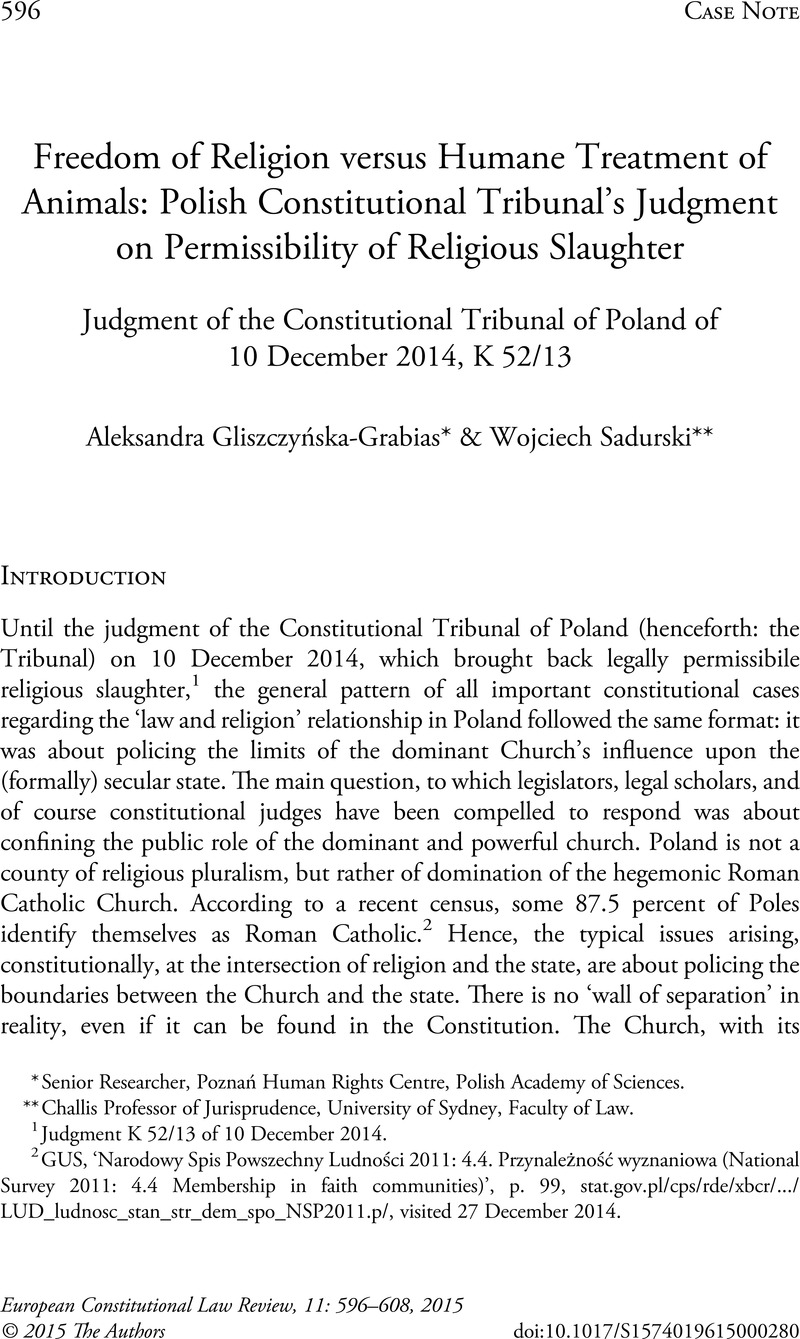Article contents
Freedom of Religion versus Humane Treatment of Animals: Polish Constitutional Tribunal’s Judgment on Permissibility of Religious Slaughter
Judgment of the Constitutional Tribunal of Poland of 10 December 2014, K 52/13
Published online by Cambridge University Press: 01 December 2015
Abstract

- Type
- Case Notes
- Information
- Copyright
- Copyright © The Authors 2015
Footnotes
Senior Researcher, Poznań Human Rights Centre, Polish Academy of Sciences.
Challis Professor of Jurisprudence, University of Sydney, Faculty of Law.
References
1 Judgment K 52/13 of 10 December 2014.
2 GUS, ‘Narodowy Spis Powszechny Ludności 2011: 4.4. Przynależność wyznaniowa (National Survey 2011: 4.4 Membership in faith communities)’, p. 99, stat.gov.pl/cps/rde/xbcr/.../LUD_ludnosc_stan_str_dem_spo_NSP2011.p/, visited 27 December 2014.
3 For a discussion of main judgments in this line of cases, see Sadurski, W., Rights Before Courts: A study of constitutional courts in postcommunist states of Central and Eastern Europe, 2nd edn. (Springer 2015) p. 188-193Google Scholar.
4 Constitution of the United States, 1st Am. For a good, classic discussion about the relationship between two religion clauses of the 1st Amendment, see Choper, J., ‘The Religion Clauses of the First Amendment: Reconciling the Conflict’, 41 U. Pitt. L. Rev. (1980) p. 673Google Scholar.
5 Judgment U 4/12 of 27 November 2012.
6 See below, under ‘Dissenting opinions’.
7 Under Polish constitutional law, churches and other faith groups have standing to lodge a constitutional challenge (in the ‘abstract’ procedure, hence not limited to ‘constitutional complaint’) against a law which concerns matters relevant to their sphere of activities, see Art. 191 of the Constitution.
8 Art. 53 of the Constitution proclaims, inter alia: ‘(1) Freedom of conscience and religion shall be ensured to everyone. (2) Freedom of religion shall include the freedom to profess or to accept a religion by personal choice as well as to manifest such religion, either individually or collectively, publicly or privately, by worshipping, praying, participating in ceremonies, performing of rites or teaching. Freedom of religion shall also include possession of sanctuaries and other places of worship for the satisfaction of the needs of believers as well as the right of individuals, wherever they may be, to benefit from religious services. … (5) The freedom to publicly express religion may be limited only by means of statute and only where this is necessary for the defence of State security, public order, health, morals or the freedoms and rights of others.’
9 Art. 9 reads: ‘(1) Everyone has the right to freedom of thought, conscience and religion; this right includes freedom to change his religion or belief and freedom, either alone or in community with others and in public or private, to manifest his religion or belief, in worship, teaching, practice and observance. (2) Freedom to manifest one’s religion or beliefs shall be subject only to such limitations as are prescribed by law and are necessary in a democratic society in the interests of public safety, for the protection of public order, health or morals, or for the protection of the rights and freedoms of others.’
10 For a graphic description of schechita slaughter, see A. Coghlan, ‘Animals feel the pain of religious slaughter’, New Scientist, 13 October 2009, www.newscientist.com/article/dn17972-animals-feel-the-pain-of-religious-slaughter/, visited 21 October 2015.
11 The Preamble to the Constitutional refers, inter alia, to ‘We, the Polish Nation - all citizens of the Republic, [b]oth those who believe in God as the source of truth, justice, good and beauty, [a]s well as those not sharing such faith but respecting those universal values as arising from other sources … [h]ereby establish this Constitution….’.
12 This point was made emphatically by Judge Wojciech Hermeliński in his dissenting opinion, Part 4.2.
13 Graglia, L.A., ‘Church of the Lukumi Babalu Aye: Of Animal Sacrifice and religious Persecution’, 85 Georgetown Law Journal (1996), p. 50Google Scholar.
14 ECtHR 27 June 2000, Case No. 27417/95, Cha’are Shalom Ve Tsedek v France.
15 E.g. Austrian Constitutional Court judgment of 17 December 1998, VfSlg 15.394.
16 Church of the Lukumi Babalu Ay, Inc. v the City of Hialeah, 508 U.S. 520 (1993).
17 A disclosure: one of the co-authors of this case note (W. Sadurski) was a co-signatory of this submission.
18 For a good overview, see Haupt, C. E., ‘Free Exercise of Religion and Animal Protection: A Comparative Perspective on Ritual Slaughter’, 39 George Washington International Law Review (2007) p. 839-886Google Scholar. See also Rovinsky, J. A., ‘The Cutting Edge: The Debate Over Regulation of Ritual Slaughter in the Western World’, 45 California Western International Law Journal (2014) p. 79-107Google Scholar and Zoethout, C. M., ‘Animals as Sentient Beings: On Animal Welfare, Public Morality and Ritual Slaughter’, Vienna Journal on International Constitutional Law (2013) p. 308Google Scholar at p. 313-315.
19 In Germany: Schächten Case, Decision of the Federal Constitutional Court, Bundesverfassungsgericht (BVerfG), 15 January 2002, 1 BvR 1783/99; in Austria: Austrian Constitutional Court, Judgment of 17 December 1998, B 3028/97, VfSlg 15394.
20 ECtHR 27 June 2000, Case No. 27417/95, Cha’are Shalom Ve Tsedek v France. For critiques of the decision, see Lerner, P. and Rabello, A. M., ‘The Prohibition of Ritual Slaughtering (Kosher Shechita and Halal) and Freedom of Religion of Minorities’, 22 Journal of Law and Religion (2007) p. 1CrossRefGoogle Scholar at p. 40.
21 Convention for the Protection of Animals for Slaughter, signed 10 May 1979, effective 11 June 1982, Official Journal L 137, 27, Art. 13.
22 Church of the Lukumi Babalu Ay, Inc.v the City of Hialeah, 508 U.S. 520 (1993).
23 Pawłowiec, D., ‘Przegrany bój o ubój’, www.uwazamrze.pl/artykul/1031527/przegrany-boj-o-uboj/, visited 21 October 2015Google Scholar.
- 5
- Cited by


